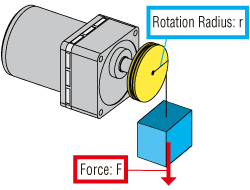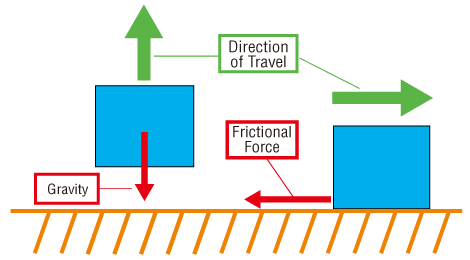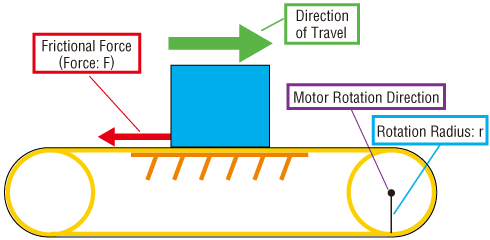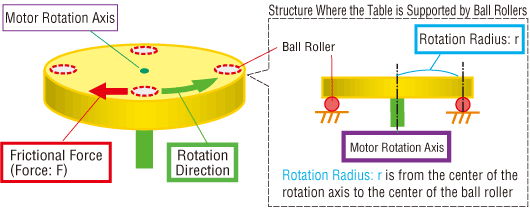What is Load Torque?


-

Hey Vex, what's wrong? Is there something in the catalog that you don't understand?
-

Oh, Ms. Ori. I saw the term "load torque" in the catalog, but I was having trouble understanding it.
-

Ok, load torque. This is the "torque that is always required when the motor is operating"....
Do you really know what is torque at the first place? -

Torque is the force of rotation, right?
-

That’s right. Just in case, let's review briefly.
Take a look at the figure below.Torque is calculated as the product of "force: F" and "rotation radius: r." - -
Assuming that "force: F" is 20 N and "rotation radius: r" is 5 cm... - -
Torque = 20 N × 0.05 m = 1.0 N·m (Newton-meter)
As I calculate it.

-

The unit of force was "Newtons" right? What is the actual size of the 20 N used in this example?
-

20 N is the force required to lift an object of about 2 kg.
-

I see. I was able to get a concrete image of the amount of torque!
-

Good to know.
Next, let's talk about load torque. Do you know what kind of force load torque is based on? -

Uh... sorry, can you explain me?
-

The source of load torque includes the forces of gravity and friction. Look at the figure below.

-

Oh, I see. The force acting downside is gravity.
In the figure that explained torque earlier, the force (20 N) that was being generated was gravity.Gravity is proportional to the mass of an object.
I think the frictional force is also... larger for heavier objects, am I right? -

That’s right. The frictional force will also increase in proportion to the mass of the object.
It also has to do with the slipperiness of the surface in contact with the object. -

I see.
The gravitational and frictional forces, which are the source of the load torque, are determined by the mass of the object and the slipperiness of the contact surfaces. -

Next, I'll explain load torque using an actual mechanism as an example.
Let's start with the case of a belt conveyor mechanism that is driven horizontally.
In the figure below, where do you think the load torque is generated?
-

Frictional force is generated in the opposite direction to the direction of movement.
-

That's right! This frictional force is the "force: F" we used to calculate the torque earlier. -
Then, the radius of the pulley becomes the "rotation radius: r". - -

It's easy to understand if you look at this figure.
-

Next, we'll look at an index table example. What do you think of the figure below?

-

Well, it's a bit more complicated when it comes to index tables. Where does the force originate...?
-

In this case, there's a frictional force at the "contact point between the ball roller and the table."
-

I see. Since this frictional force is the "force: F"... -
The "rotation radius: r" is the distance from the "motor's axis of rotation" to the "contact point between the ball roller and the table." -

That's right, Vex. You're starting to get the idea of load torque.
-

Yes But Ms. Ori. There's one thing that bothering me...
-

What is it?
-

Friction changes with use, doesn't it? Doesn't the load torque change as well?
-

Wow, Vex. That’s a very good point. You're right! You'll have more friction and more load torque with over time.
-

But then, won't the motor lock up because the load torque is higher than the value intended at the design stage?
-

That’s right. That's why the safety factor is taken into account at the design stage. Make sure there's enough torque margin in the motor. And one more thing. There's also a way to check the load factor. If you can tell that the motor torque is not enough before it locks up, you can take action quickly.
-

I see. That's a good idea. I'm sure there are products with the function to display the load factor... But hmmm... Which one was it?
-

Pull yourself together! There are brushless motors, αSTEP, servo motors, all sorts of things. The method of checking varies depending on the product, so take a look at FAQ "Is there a way to check the generated torque (load torque)?" to learn more.
-

Yes, I understand!
- February 15, 2021 Updated with the latest information.
Related Content
Teach Me Please! Ms. Ori "Does output torque increase as gear ratio increases?"